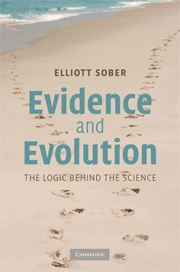Conclusion
Published online by Cambridge University Press: 05 June 2012
Summary
I won't try to summarize the preceding four chapters, but I do want to describe some of their main themes.
NO PROBABILISTIC MODUS TOLLENS
The lazy way to test a hypothesis H is to focus on one of its possible competitors H0, claim that the data refute H0, and then declare that H is the only hypothesis left standing. This is an attractive strategy if you are fond of the hypothesis H but are unable to say what testable predictions H makes. I have nothing against laziness per se. If H0 really is the only alternative to H, and if H0 really does deductively entail some observation statement O that turns out to be false, then it really does follow that H0 is false and H is true. The examples discussed in this book do not exhibit this tidy pattern.
It is false that the only alternative to intelligent design is gradual evolution by natural selection in an infinite population (§2.16), though it is true that this particular hypothesis does entail that fitness valleys cannot be crossed. Suppose we consider, instead, an evolutionary model that says that valleys can be crossed. If we want to test this evolutionary hypothesis against the hypothesis of intelligent design, the question we need to consider is contrastive: Does the evolutionary hypothesis or the intelligent-design hypothesis make the observations more probable? Intelligent-design proponents can't leave their “theory” in the background in the hope that evolutionary theory will shoot itself in the foot.
- Type
- Chapter
- Information
- Evidence and EvolutionThe Logic Behind the Science, pp. 353 - 367Publisher: Cambridge University PressPrint publication year: 2008



